
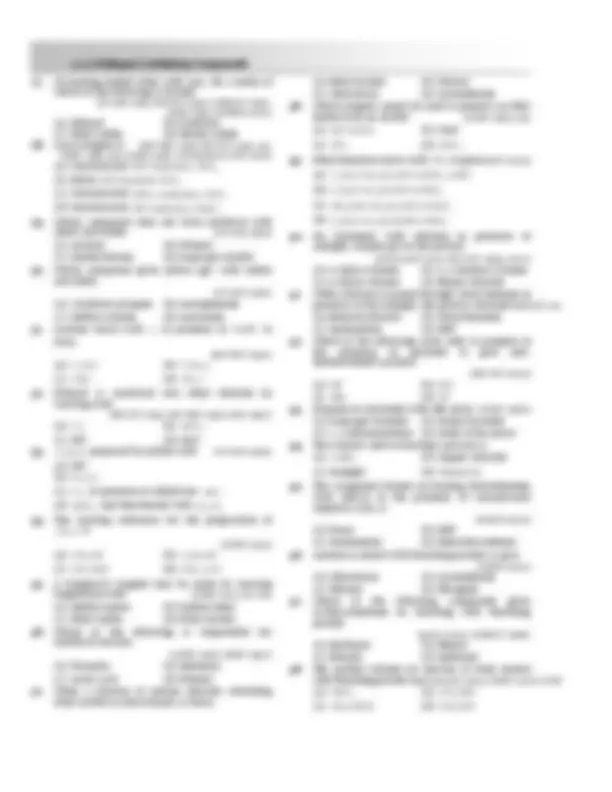
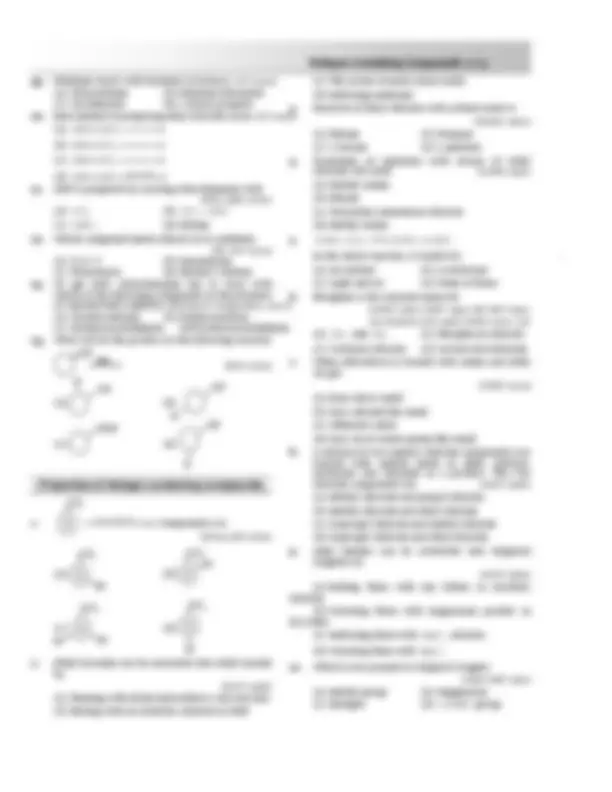
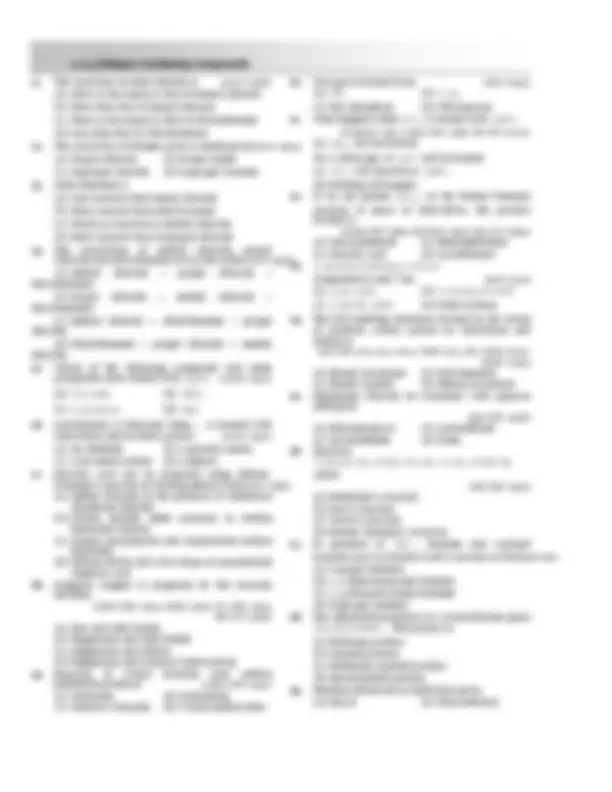
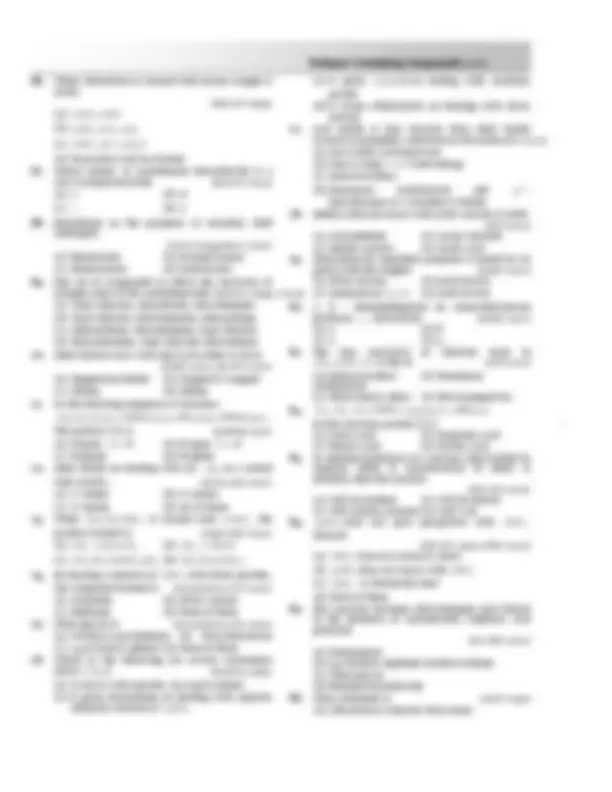
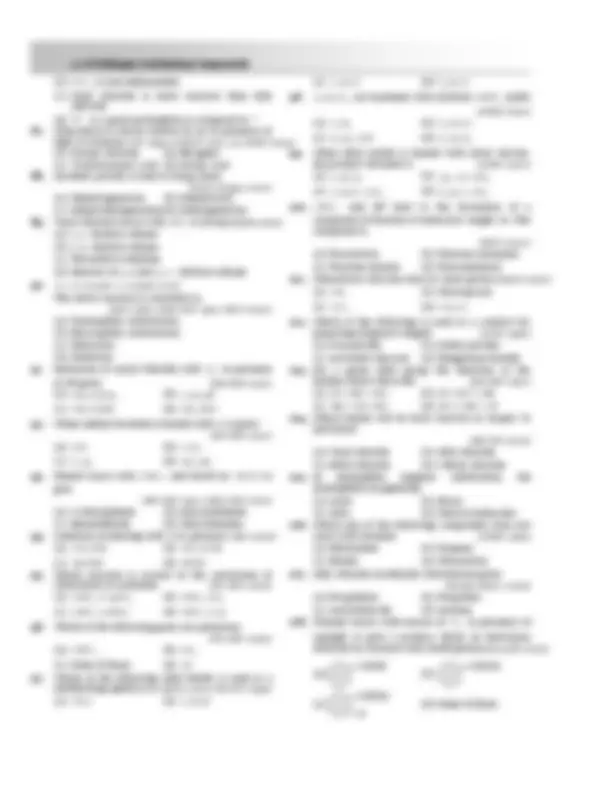
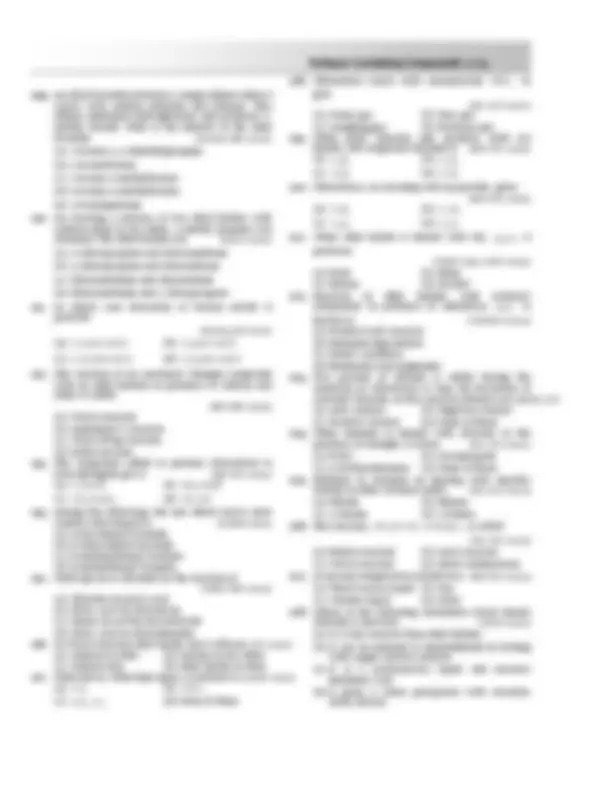
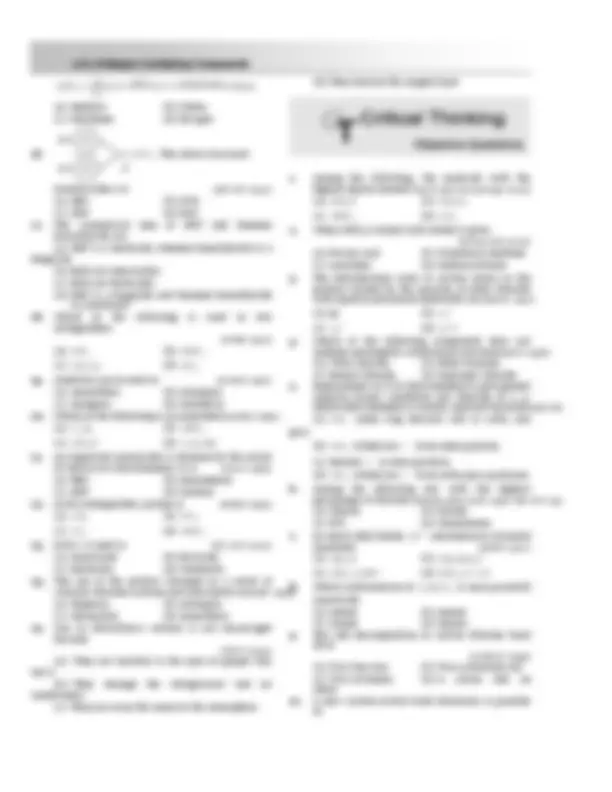
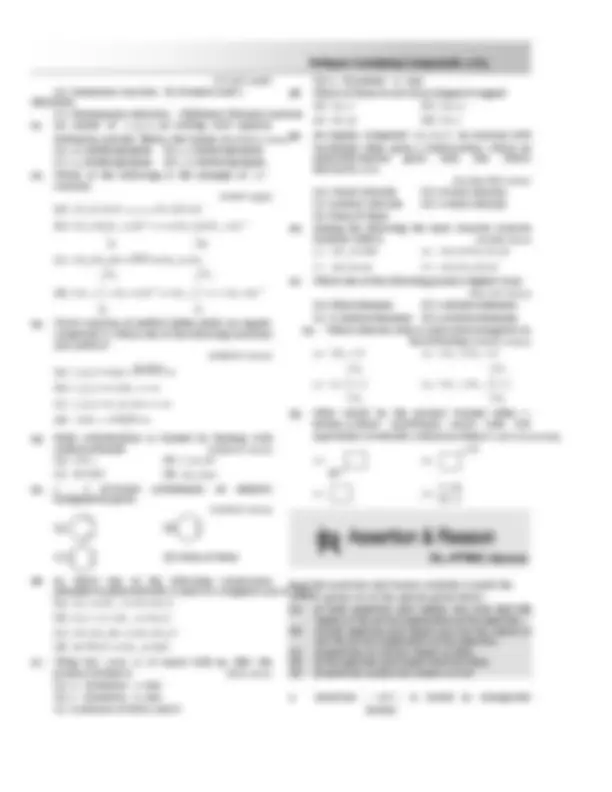
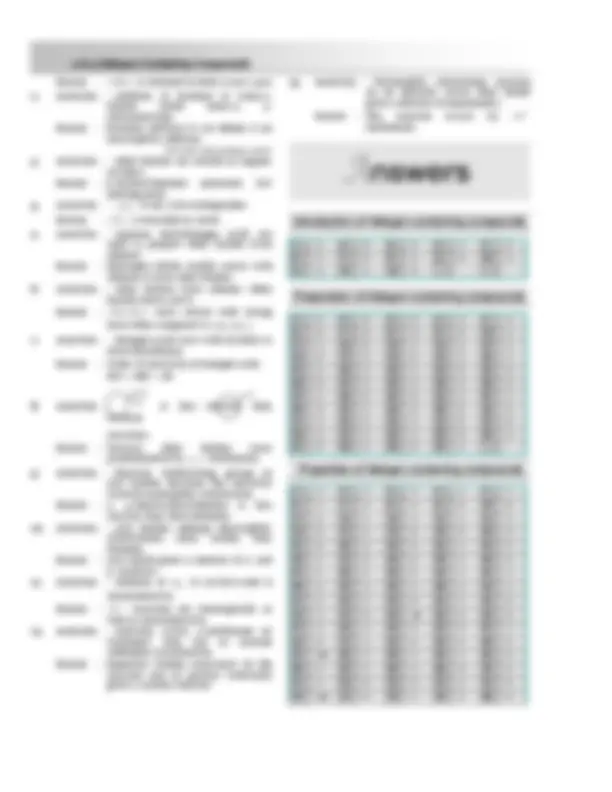
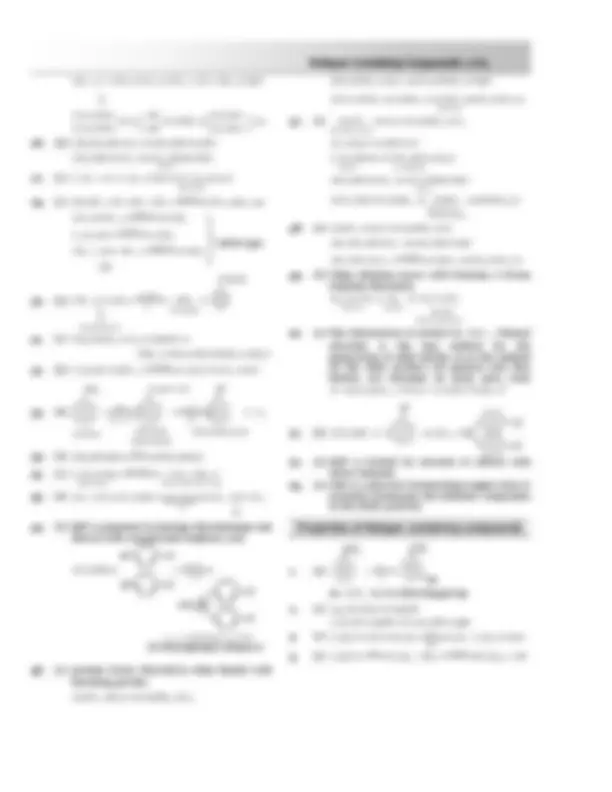
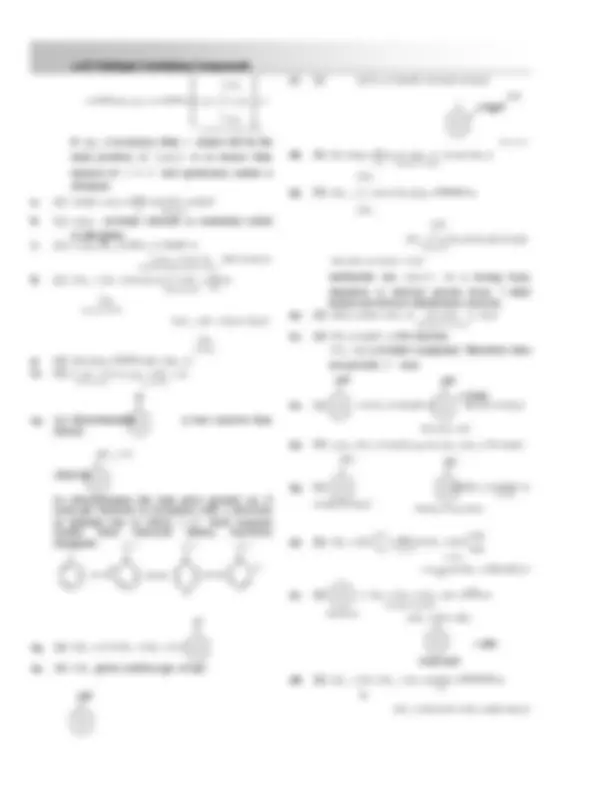
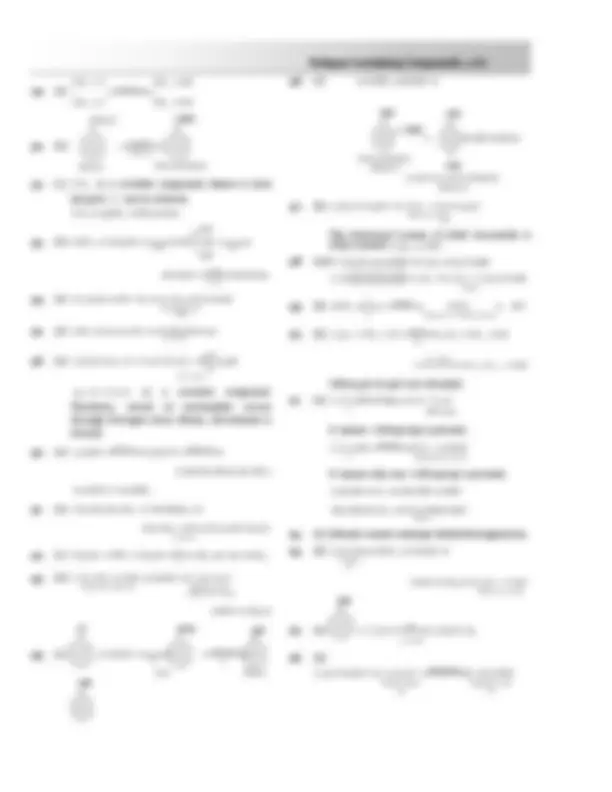
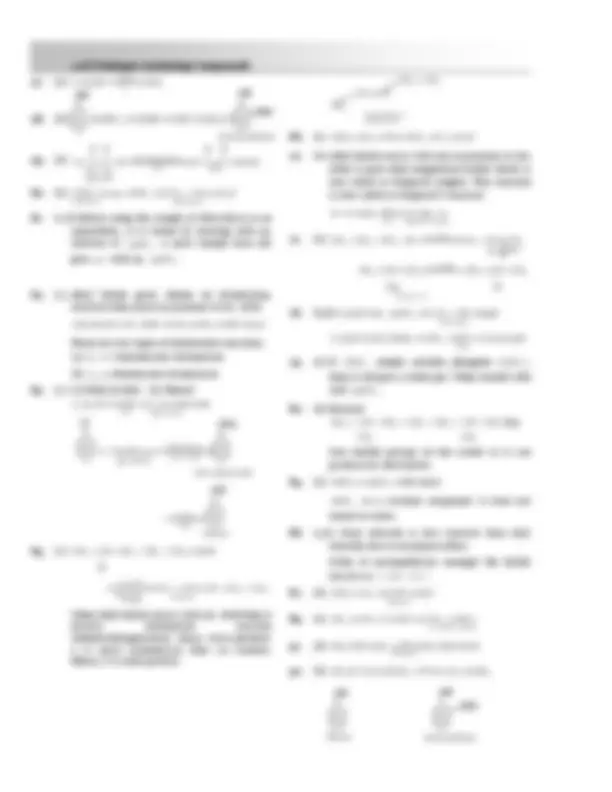
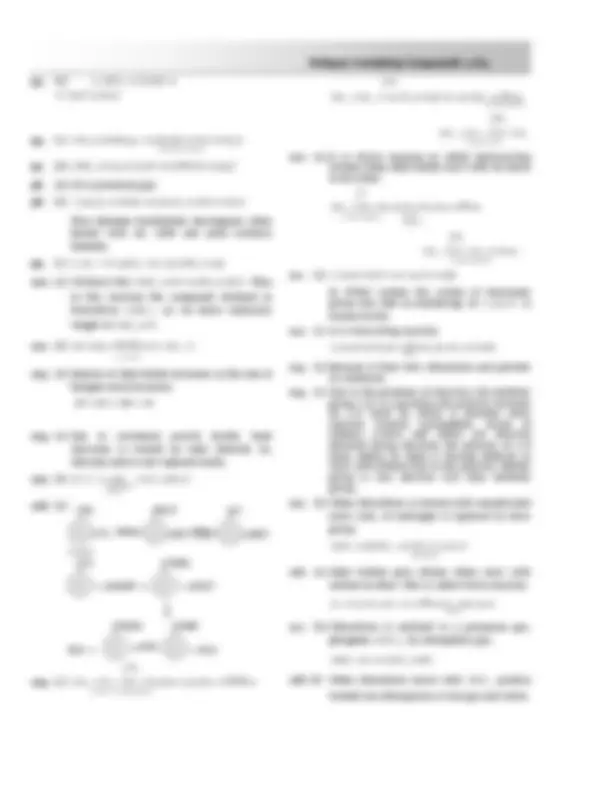
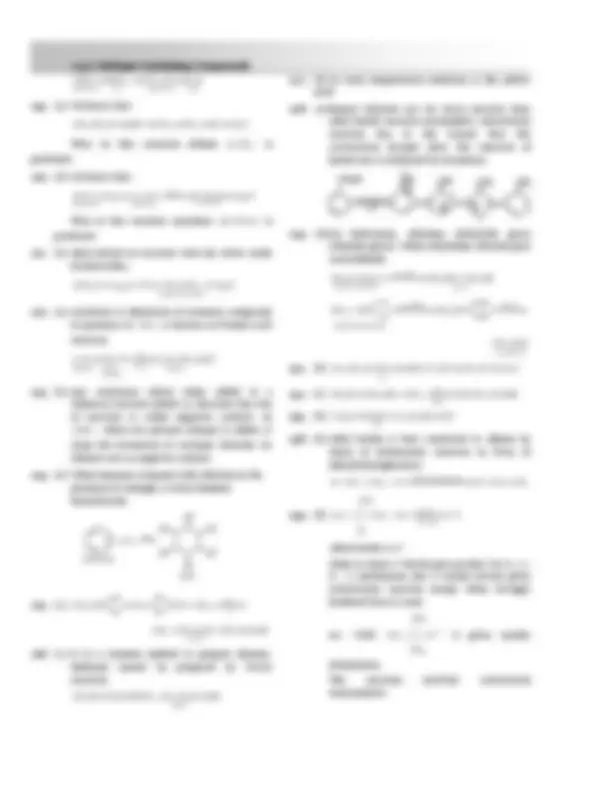
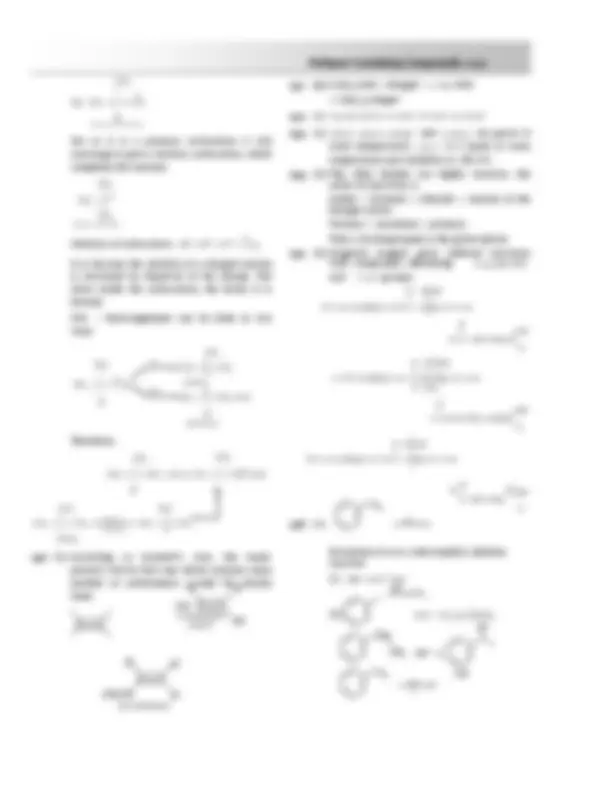
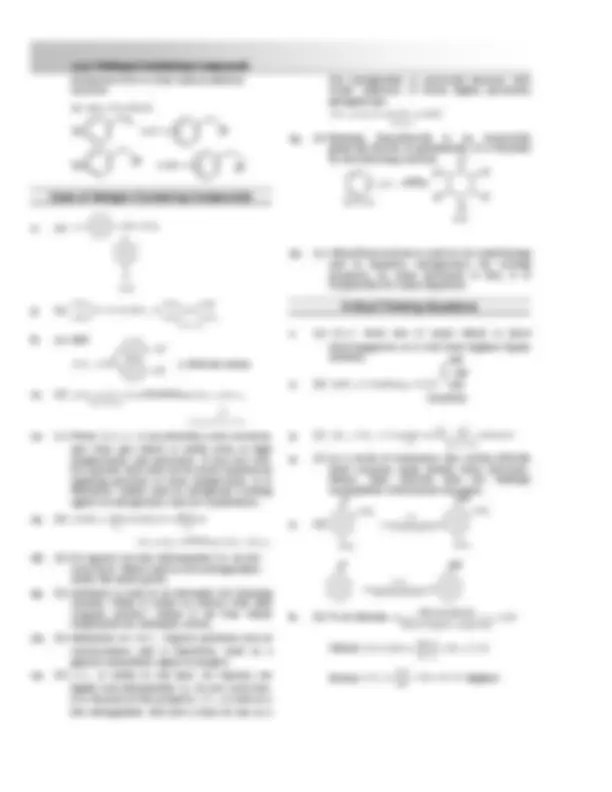
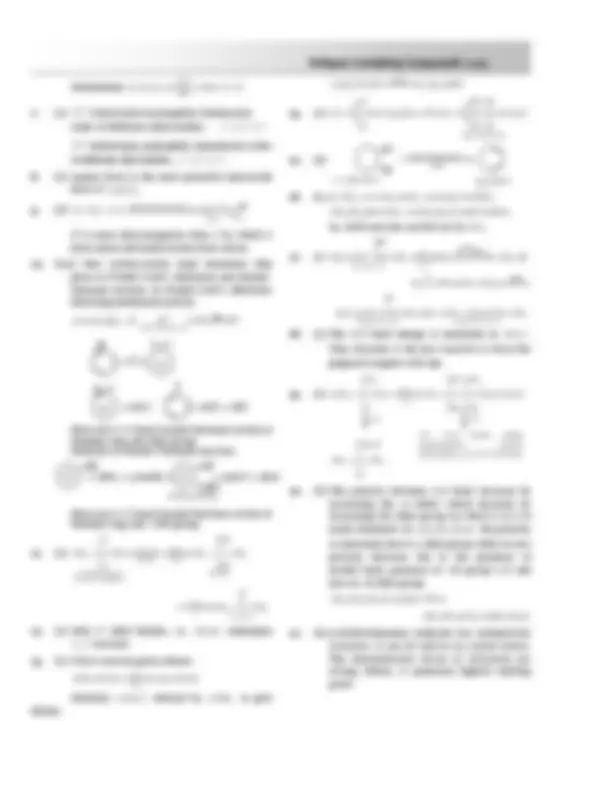
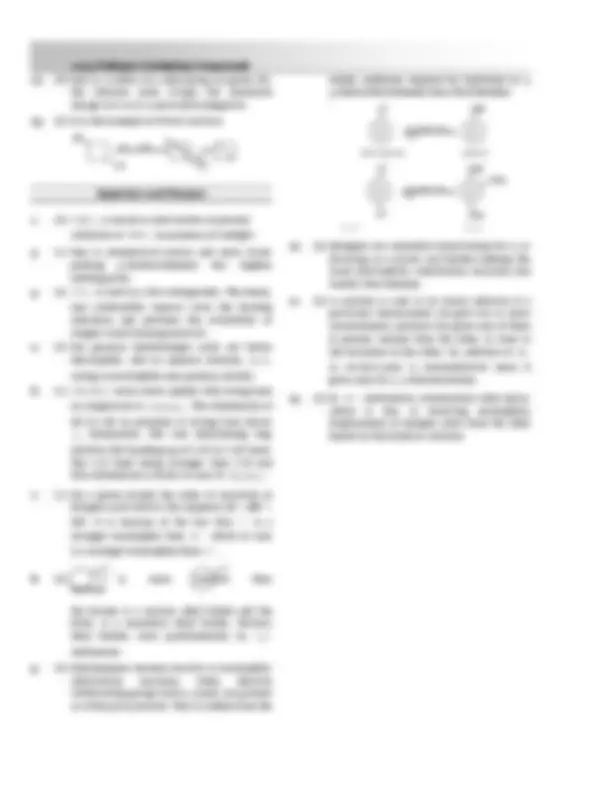


Study with the several resources on Docsity

Earn points by helping other students or get them with a premium plan


Prepare for your exams
Study with the several resources on Docsity

Earn points to download
Earn points by helping other students or get them with a premium plan
Community
Ask the community for help and clear up your study doubts
Discover the best universities in your country according to Docsity users
Free resources
Download our free guides on studying techniques, anxiety management strategies, and thesis advice from Docsity tutors
it contains questions and their answers as well.
Typology: Assignments
1 / 27

This page cannot be seen from the preview
Don't miss anything!




















1. How many structural isomers are possible for a
compound with molecular formula C HCl
3 7
[MH CET 2001]
(a) 2 (b) 5
(c) 7 (d) 9
2. In ,% 3 2
CHCH Br of Br is [DPMT 1996]
(a) 80 (b) 75
(c) 70 (d) 7
3. Gem- dibromide is [RPMT 2000]
(a)
3 3
CHCH ( Br ) OH ( Br ) CH
(b)
3 2 3
CHCBrCH
(c)
2 2 2
CH ( Br ) CHCH
(d) CH BrCHBr
2 2
4. Ethylidene dibromide is
(a) CH CH Br
3 2
(b) Br CH CH Br
2 2
(c)
3 2
CH CHBr (d)
2 2
CH CBr
5. Benzylidene chloride is
(a) C HCHCl
6 5 2
(b)
6 5 2
CHCHCl
(c) C HClCH Cl
6 4 2
(d)
6 5 3
CHCCl
6. Which of the following halide is
o
2
(a) Isopropyl chloride (b) Isobutyl chloride
(c) n - propyl chloride (d) n- butyl chloride
7. Haloforms are trihalogen derivatives of [CPMT 1985]
(a) Ethane (b) Methane
(c) Propane (d) Benzene
8. Benzene hexachloride is
(a) 1, 2, 3, 4, 5, 6-hexachlorocyclohexane
(b) 1, 1, 1, 6, 6, 6-hexachlorocyclohexane
(c) 1, 6-phenyl-1, 6-chlorohexane
(d) 1, 1-phenyl-6, 6-chlorohexane
9. Number of bonds present in B.H.C. (Benzene
hexachloride) are [RPMT 1999]
(a) 6 (b) Zero
(c) 3 (d) 12
10. The general formula for alkyl halides is
(a) C H X
n 2 n 1
(b) C H X
n 2 n 2
(c) C H X
n n 1
(d) C H X
n 2 n
11. Which of the following is a primary halide [DCE 2004]
(a) Isopropyl iodide (b) Secondary butyl
iodide
(c) Tertiary butyl bromide (d)Neo hexyl chloride
12. Full name of DDT is [KCET 1993]
(a) 1, 1, 1 - trichloro-2, 2 - bis ( p- chlorophenyl)
ethane
(b) 1, 1-dichloro-2, 2-diphenyl trimethylethane
(c) 1, 1-dichloro-2, 2-diphenyl trichloroethane
(d) None of these
13. The compound which contains all the four
o o o
1 , 2 , 3 and
o
4 carbon atoms is [J & K 2005]
(a) 2, 3-dimethyl pentane
(b) 3 - chloro-2, 3-dimethylpentane
(c) 2, 3, 4-trimethylpentane
(d) 3, 3-dimethylpentane
1. The following reaction is known as
C HOH SOCl CHCl SO HCl
2 5 2
Py ridine
2 5 2
[AIIMS 2002]
(a) Kharasch effect
(b) Darzen’s procedure
(c) Williamson’s synthesis
(d) Hunsdiecker synthesis reaction
2. What is the main product of the reaction between
2 - methyl propene with HBr [RPMT 2002]
(a) 1 - bromo butane
(b) 1 - bromo-2 methyl propane
(c) 2 - bromo butane
(d) 2 - bromo-2 methyl propane
3. Halogenation of alkanes is [KCET 2002]
(a) A reductive process (b) An oxidative process
(c) An isothermal process (d)An indothermal process
4
In the above process product A is [Kerala (Engg.) 2002]
(a) Fluorobenzene (b) Benzene
(c) 1, 4-difluorobenzene (d) 1, 3-difluorobenzene
5. Silver acetate
2
CS
2
Br. The main product of
this reaction is [Kurukshetra CET 2002]
(a) CH Br
3
(b) CH COI
3
(c) CH COOH
3
(d) None of these
6. Diazonium salts ,
2 2
CuCl HCl
the
reaction is known as [Kerala (Med.) 2002]
(a) Chlorination (b) Sandmeyer’s reaction
(c) Perkin reaction (d) Substitution reaction
7. When ethyl alcohol( )
2 5
CHOH reacts with thionyl
chloride, in the presence of pyridine, the product
obtained is
[AIIMS; CBSE PMT 2001]
Cl
(a) CH CHCl HCl
3 2
(b)
2 5 2
C HCl HCl SO
(c)
3 2 2 2
CH CHCl HO SO
(d)
3 2 2
CH CH Cl HCl SO
8. Preparation of alkyl halides in laboratory is least
preferred by [DPMT 2000]
(a) Treatment of alcohols
(b) Addition of hydrogen halides to alkenes
(c) Halide exchange
(d) Direct halogenation of alkanes
9. Which of the following organic compounds will
give a mixture of 1 - chlorobutane and 2 -
chlorobutane on chlorination [CPMT 2001]
(a)
2
3
|
3
(b)
2
|
CH
H
HC C C
(c)
2 2
(d)
2 2 3
10. The chlorobenzene is generally obtained from a
corresponding diazonium salt by reacting it with
[MP PMT 2000]
(a)
2 2
CuCl (b)
4
CuSO
(c) Cu
(d)
2
3 4
Cu ( NH )
11. Decreasing order of reactivity of HX in the
reaction ROH HX RX HO
2
[RPET 2000; AIIMS 1983; MP PET 1996]
(a) HI HBr HCl HF (b) HBr HCl HI HF
(c) HCl HBr HI HF (d) HF HBr HCl HI
12. The product of the following reaction :
CH CH CCl HBr
2 3
[RPET 2000]
(a)
3 3
CH CH ( Br ) CCl
(b)
2 2 3
CH ( Br ) CH CCl
(c)
2 2
BrCH CHCl CHCl
(d)
3 2 3
CH CH CCl
13. Chlorobenzene is prepared commercially by
[JIPMER 2000; CPMT 1976; Pb. CET 2002]
(a) Raschig process (b) Wurtz Fitting
reaction
(c) Friedel-Craft’s reaction (d) Grignard reaction
14. In methyl alcohol solution, bromine reacts with
ethylene to yield
2 2 3
BrCHCHOCH in addition to 1,
2 - dibromoethane because [Pb. PMT 1998]
(a) The ion formed initially may react with
Br or
3
(b) The methyl alcohol solvates the bromine
(c) The reaction follows Markownikoff's rule
(d) This is a free-radical mechanism
15. C H Cl CHCl HCl 3 7
Light
3 8 2
is an example of
which of the following types of reactions
[AFMC 1997; CPMT 1999]
(a) Substitution (b) Elimination
(c) Addition (d) Rearrangement
16. Which of the following would be produced when
acetylene reacts with HCl [MH CET 1999]
(a) CH CHCl
3 2
(b)
3 2
CHCHCl
(c) CHCl CHCl (d) CH CHCl
2
2
In the above reaction, the reactivity of different
alcohols is
[CPMT 1997]
(a) Tertiary > Secondary > Primary
(b) Tertiary < Secondary < Primary
(c) Tertiary < Secondary > Primary
(d) Secondary < Primary < Tertiary
Light
6 6 2
UV
CH Cl Product. In above reaction
product is [CPMT 1997]
(a) CCl CHO
3
(b)
6 6 6
CHCl
(c)
6 12 6
CH Cl (d)
6 9 2
CHCl
19. Benzene reacts with chlorine to form benzene
hexachloride in presence of [MP PET 1999]
(a) Nickel (b)
3
AlCl
(c) Bright sunlight (d) Zinc
20. The final product obtained by distilling ethyl
alcohol with the excess of chlorine and
2
Ca ( OH ) is [MP PET 1996]
(a) CH CHO
3
(b) CClCHO
3
(c)
3
CHCl (d) CH O
3 2
21. When ethyl alcohol and KI reacted in presence of
2 3
NaCO
yellow crystals of...... are formed [AFMC 1989]
(a)
3
CHI (b) CH I
3
(c)
2 2
CHI (d) C HI
2 5
22. In preparation of
3
CHCl from ethanol and
bleaching powder, the latter provides [BHU 1986]
(a)
2
Ca ( OH ) (b)
2
Cl
(c) Both (a) and (b) (d) None of these
23. Which one of the following processes does not
occur during formation of
3
CHCl from C HOH
2 5
and bleaching powder
[DPMT 1984]
(a) Hydrolysis (b) Oxidation
(c) Reduction (d) Chlorination
24. Which of the following is obtained when chloral is
boiled with NaOH [CBSE PMT 1991; RPMT 1999]
(a) CH Cl
3
(b)
3
CHCl
(c)
4
CCl (d) None of these
25. Chloroform can be obtained from [MNR 1986]
(a) Methanol (b) Methanal
(c) Propanol- 1 (d) Propanol- 2
26. Chlorine reacts with ethanol to give
[MP PMT 1989; CPMT 1997; KCET 1998; JIPMER 1999]
(a) Ethyl chloride (b) Chloroform
(c) Acetaldehyde (d) Chloral
49. Ethylene reacts with bromine to form [Pb. CET 2000]
(a) Chloroethane (b) Ethylene dibromide
(c) Cyclohexane (d) 1 - bromo propane
50. Best method of preparing alkyl chloride is [MH CET 2004]
(a)
2
ROH SOCl
(b)
5
ROH PCl
(c)
3
ROH PCl
(d)
2
anhy. ZnCl
ROH HCl
51. DDT is prepared by reacting chlorobenzene with
[BHU 1998, 2005]
(a)
4
CCl (b) CCl CHO
3
(c)
3
CHCl (d) Ethane
52. Which compound needs chloral in its synthesis
[Pb. PET 2003]
(a) D. D. T. (b) Gammexane
(c) Chloroform (d) Michler’s Ketone
53. To get DDT , chlorobenzene has to react with
which of the following compounds in the presence
of concentrated sulphuric acid [KCET (Engg/Med.) 2001]
(a) Trichloroethane (b) Dichloroacetone
(c) Dichloroacetaldehyde (d)Trichloroacetaldehyde
54. What will be the product in the following reaction
[BHU 2005]
(a) (b)
(c) (d)
1 eqv.of Br / Fe 2
A. Compounds A is
[Orissa JEE 2005]
(a) (b)
(c) (d)
2. Ethyl bromide can be converted into ethyl alcohol
by
[KCET 1989]
(a) Heating with dilute hydrochloric acid and zinc
(b) Boiling with an alcoholic solution of KOH
(c) The action of moist silver oxide
(d) Refluxing methanol
3. Reaction of ethyl chloride with sodium leads to
[NCERT 1984]
(a) Ethane (b) Propane
(c) n - butane (d) n - pentane
4. Treatment of ammonia with excess of ethyl
chloride will yield [AIIMS 1992]
(a) Diethyl amine
(b) Ethane
(c) Tetraethyl ammonium chloride
(d) Methyl amine
5. CHCl O COCl HCl
X
2 2 2
3 2 2
In the above reaction, X stands for [CPMT 1985]
(a) An oxidant (b) A reductant
(c) Light and air (d) None of these
6. Phosgene is the common name for
[DPMT 1983; CPMT 1993; MP PMT 1994;
Kurukshetra CEE 1998; RPMT 2000, 02]
(a)
2
CO and
3
PH (b) Phosphoryl chloride
(c) Carbonyl chloride (d) Carbon tetrachloride
7. When chloroform is treated with amine and KOH ,
we get
[CPMT 1979]
(a) Rose odour smell
(b) Sour almond like smell
(c) Offensive odour
(d) Sour oil of winter green like smell
8. A mixture of two organic chlorine compounds was
treated with sodium metal in ether solution.
Isobutane was obtained as a product. The two
chlorine compounds are [KCET 1988]
(a) Methyl chloride and propyl chloride
(b) Methyl chloride and ethyl chloride
(c) Isopropyl chloride and methyl chloride
(d) Isopropyl chloride and ethyl chloride
9. Alkyl halides can be converted into Grignard
reagents by
[KCET 1989]
(a) Boiling them with Mg ribbon in alcoholic
solution
(b) Warming them with magnesium powder in
dry ether
(c) Refluxing them with
2
MgCl solution
(d) Warming them with
2
MgCl
10. Which is not present in Grignard reagent
[CBSE PMT 1991]
(a) Methyl group (b) Magnesium
(c) Halogen (d) COOH group
2
3
r
3
r CH 2
r
r
3
CCl 3
CCl 3
Br
CCl 3
Br
CCl 3
Br Br
CCl 3
Br
11. The reactivity of ethyl chloride is [KCET 1986]
(a) More or less equal to that of benzyl chloride
(b) More than that of benzyl chloride
(c) More or less equal to that of chlorobenzene
(d) Less than that of chlorobenzene
12. The reactivity of halogen atom is minimum in [KCET 1985]
(a) Propyl chloride (b) Propyl iodide
(c) Isopropyl chloride (d) Isopropyl bromide
13. Chlorobenzene is
(a) Less reactive than benzyl chloride
(b) More reactive than ethyl bromide
(c) Nearly as reactive as methyl chloride
(d) More reactive than isopropyl chloride
14. The reactivities of methyl chloride, propyl
chloride and chlorobenzene are in the order [KCET 1988]
(a) Methyl chloride > propyl chloride >
chlorobenzene
(b) Propyl chloride > methyl chloride >
chlorobenzene
(c) Methyl chloride > chlorobenzene > propyl
chloride
(d) Chlorobenzene > propyl chloride > methyl
chloride
15. Which of the following compound will make
precipitate most readily with
3
AgNO [CPMT 1992]
(a) CCl CHO
3
(b)
3
CHCl
(c) C HCHCl
6 5 2
(d)
3
16. Carbylamine is liberated when..... is heated with
chloroform and alcoholic potash [KCET 1992]
(a) An aldehyde (b) A primary amine
(c) A secondary amine (d) A phenol
17. Salicylic acid can be prepared using Reimer-
Tiemann's reaction by treating phenol with [KCET 1989]
(a) Methyl chloride in the presence of anhydrous
aluminium chloride
(b) Carbon dioxide under pressure in sodium
hydroxide solution
(c) Carbon tetrachloride and concentrated sodium
hydroxide
(d) Sodium nitrite and a few drops of concentrated
sulphuric acid
18. Grignard reagent is prepared by the reaction
between
[CBSE PMT 1994; DPMT 1996; Pb. PMT 1999;
MH CET 1999]
(a) Zinc and alkyl halide
(b) Magnesium and alkyl halide
(c) Magnesium and alkane
(d) Magnesium and aromatic hydrocarbon
19. Reaction of t - butyl bromide with sodium
methoxide produces [CBSE PMT 1994]
(a) Isobutane (b) Isobutylene
(c) Sodium t - butoxide (d) t - butyl methyl ether
20. War gas is formed from [BHU 1995]
(a)
3
PH (b)
2 2
(c) Zinc phosphate (d) Chloropicrin
21. What happens when
4
CCl is treated with
3
AgNO
[EAMCET 1987; CBSE PMT 1988; MP PET 2000]
(a)
2
will be evolved
(b) A white ppt. of AgCl will be formed
(c)
4
CCl will dissolve in
3
AgNO
(d) Nothing will happen
22. If we use pyrene ( )
4
CCl
in the Riemer-Tiemann
reaction in place of chloroform, the product
formed is
[CBSE PMT 1989; MP PMT 1990; MH CET 1999]
(a) Salicylaldehyde (b) Phenolphthalein
(c) Salicylic acid (d) Cyclohexanol
C HCHCl KCN ( aq .) X Y
6 5 2
Compounds X and Y are [BHU 1979]
(a) C H KCl
6 6
(b) C HCHCN KCl
6 5 2
(c) C HCH KCl
6 5 3
(d) None of these
24. The bad smelling substance formed by the action
of alcoholic caustic potash on chloroform and
aniline is
[MP PMT 1971, 92, 2001; CPMT 1971, 86; AFMC 2002;
RPMT 1999]
(a) Phenyl isocyanide (b) Nitrobenzene
(c) Phenyl cyanide (d) Phenyl isocyanate
25. Ethylidene chloride on treatment with aqueous
KOH gives
[MP PMT 1986]
(a) Ethylene glycol (b) Acetaldehyde
(c) Formaldehyde (d) None
26. Reaction
C HI CH I 2 Na CH CH 2 NaI
2 5 5 11 2 5 5 11
is
called
[MP PMT 1992]
(a) Hoffmann's reaction
(b) Dow's reaction
(c) Wurtz's reaction
(d) Riemer-Tiemann's reaction
27. In presence of ,
3
AlCl benzene and n - propyl
bromide react in Friedal-Craft's reaction to form [MP PMT 1991]
(a) n - propyl benzene
(b) 1, 2-dinormal propyl benzene
(c) 1, 4-dinormal propyl benzene
(d) Isopropyl benzene
28. The dehydrobromination of 2-bromobutane gives
3 3
CH CH CHCH The product is
(a) Hofmann product
(b) Saytzeff product
(c) Hoffmann-Saytzeff product
(d) Markownikoff product
29. Ethylene difluoride on hydrolysis gives
(a) Glycol (b) Fluoroethanol
(a) C H Br
2 5
reacts with alco. KOH to form
2 5
(b) C H Br
2 5
when treated with metallic sodium
gives ethane
(c) C H Br
2 5
when treated with sodium ethoxide
forms diethyl ether
(d) C H Br
2 5
with AgCN forms ethyl isocyanide
49. When chloroform is exposed to air and sunlight, it
gives
[NCERT 1984; CPMT 1978, 87; CBSE PMT 1990;
EAMCET 1993; MNR 1994; MP PET 1997, 2000;
BHU 2001; AFMC 2002]
(a) Carbon tetrachloride (b) Carbonyl chloride
(c) Mustard gas (d) Lewsite
50. An organic halide is shaken with aqueous NaOH
followed by the addition of dil.
3
HNO and silver
nitrate solution gave white ppt. The substance can
be [JIPMER 1997]
(a) C H ( CH ) Br
6 4 3
(b) C HCHCl
6 5 2
(c) C HCl
6 5
(d) None of these
51. A compound A has a molecular formula .
2 3
CClOH
It reduces Fehling solution and on oxidation gives
a monocarboxylic acid ( B ). A is obtained by action
of chlorine on ethyl alcohol. A is
[CBSE PMT 1994; MP PET 1997; KCET 2005]
(a) Chloral (b)
3
CHCl
(c) CH Cl
3
(d) Chloroacetic acid
52. Following equation illustrates
C HCl NaOH CHONa NaCl HO
atm
C
o
6 5 2
200
200250
6 5
[Bihar CEE 1995]
(a) Dow's process (b) Kolbe's process
(c) Carbylamine test (d) Haloform reaction
53. One of the following that cannot undergo
dehydro-halogenation is [J & K 2005]
(a) Iso-propyl bromide (b) Ethanol
(c) Ethyl bromide (d) None of these
54. A compound X on reaction with chloroform and
NaOH gives a compound with a very unpleasant
odour. X is
[MP PMT 1999]
(a)
6 5 2
CHCONH (b)
6 5 2
(c)
6 5 2 3
(d)
6 5 3
In the above reaction product is
(a)
6 5 2 5
CHOCH (b)
2 5 2 5
(c)
6 5 6 5
(d) C HI
6 5
Hy droly sis
2 5
C HCl KCN X Y ' X ' and ' Y ' are
[MP PET 1995]
(a)
2 6
CH and C HCN
2 5
(b) C HCN
2 5
and
2 6
(c) C HCN
2 5
and
2 5 2 2
(d) C HCN
2 5
and C HCOOH
2 5
57. Iodoform is formed on warming
2
I and NaOH
with
[MP PET 1995; DCE 1999; RPET 1999; RPMT 2002]
(a) C HOH
2 5
(b) CH OH
3
(c) HCOOH (d)
6 6
58. Which of the following reacts with phenol to give
salicylaldehyde after hydrolysis [MP PMT 1995]
(a) Dichloromethane (b) Trichloromethane
(c) Methyl chloride (d) None of these
59. Dehydrohalogenation in monohaloalkanes
produces
(a) A single bond (b) A double bond
(c) A triple bond (d) Fragmentation
60. When chloroform is treated with conc.
3
HNO it
gives
[CPMT 1986; MP PMT 1989; AFMC 1998, 99;
EAMCET 1991; BHU 1999]
(a)
2 2
CHCl NO (b)
3 2
CClNO
(c)
2 3
CHClHNO (d) None of these
61. A sample of chloroform being used as anaesthetic
is tested by [AIIMS 1980; CPMT 1983]
(a) Fehling solution
(b) Ammoniacal
2 2
CuCl
(c)
3
AgNO
solution
(d)
3
AgNO
solution after boiling with alcoholic
KOH solution
62. Dehydrohalogenation of an alkyl halide is [MP PMT 1996]
(a) An addition reaction (b) A substitution
reaction
(c) An elimination reaction (d)An oxidation reaction
63. Reaction of aqueous sodium hydroxide on (i) ethyl
bromide and (ii) chlorobenzene gives
(a) (i) Ethene and (ii) o- chlorophenol
(b) (i) Ethyl alcohol and (ii) o- chlorophenol
(c) (i) Ethyl alcohol and (ii) phenol
(d) (i) Ethyl alcohol and (ii) no reaction
64. 2 - bromopentane is heated with potassium
ethoxide in ethanol. The major product obtained
is [CBSE PMT 1998]
(a) Pentene- 1 (b) cis pentene- 2
(c) trans pentene- 2 (d) 2 - ethoxypentane
65. What is the product formed in the following
reaction
H
NaOH
C HOH CCl
( 2 )
( 1 )
6 5 4
[KCET 1998]
(a) p - hydroxybenzoic acid (b) o - hydroxybenzoic acid
(c) Benzaldehyde (d) Salicylaldehyde
Product
2 5
2 5
Anhy drous( )
2 5
OC H
CHOH
CH I
OH
66. When chloroform is treated with excess oxygen it
forms
[MH CET 1999]
(a) COCl HCl
2
(b)
2 2 2
COCl Cl H
(c) COCl Cl HO
2 2 2
(d) No product will be formed
67. Which isomer of cyclohexane hexachloride is a
very strong insecticide [MP PET 2003]
(a) (b)
(c)
(d)
68. Haloalkane in the presence of alcoholic KOH
undergoes
[KCET (Engg/Med.) 2002]
(a) Elimination (b) Polymerisation
(c) Dimerisation (d) Substitution
69. The set of compounds in which the reactivity of
halogen atom in the ascending order is [KCET (Engg.) 2002]
(a) Vinyl chloride, chlorethane, chlorobenzene
(b) Vinyl chloride, chlorobenzene, chloroethane
(c) Chloroethane, chlorobenzene, vinyl chloride
(d) Chlorobenzene, vinyl chloride chloroethane
70. Alkyl halides react with Mg in dry ether to form
[DPMT 2000; MP PET 2001]
(a) Magnesium halide (b) Grignard’s reagent
(c) Alkene (d) Alkyne
71. In the following sequence of reactions
( ) () (),
( .)
3 2 2
CH CHCHBr A B C
KOH(alc) HBr KOHaq
The product ( C ) is [JIPMER 2001]
(a) Propan – 2 - ol (b) Propan – l – ol
(c) Propyne (d) Propene
72. Alkyl halide on heating with alc.
3
in a sealed
tube results… [Orissa JEE 2002]
(a) 1° amine (b) 2° amine
(c) 3° amine (d) All of these
73. When 3 2 2
CHCHCHCl is treated with
2 ,
NaNH the
product formed is [CBSE PMT 2002]
(a)
3 2
CH CH CH (b) CH C CH
3
(c) ( )( )
3 2 2
CH CHCHNH Cl (d)
3 2 22
74. By heating a mixture of 3
CHCl with silver powder,
the compound formed is [Kurukshetra CET 2002]
(a) Acetylene (b) Silver acetate
(c) Methanol (d) None of these
75. Chloropicrin is [Kurukshetra CET 2002]
(a) Trichloro acetaldehyde (b) Nitrochloroform
(c) 2,4,6-trinitro phenol (d) None of these
76. Which of the following are correct statements
about C HBr
2 5
[Roorkee 1999]
(a) It reacts with metallic Na to give ethane
(b) It gives nitroethane on heating with aqueous
ethanolic solution of
2
AgNO
(c) It gives C HOH
2 5
on boiling with alcoholic
potash
(d) It forms ethylacetate on heating with silver
acetate
77. Aryl halide is less reactive than alkyl halide
towards nucleophilic substitution because [RPMT 2002]
(a) Less stable carbonium ion
(b) Due to large C Cl bond energy
(c) Inductive effect
(d) Resonance stabilization and
2
sp -
hybridisation of C attached to halide
78. Methyl chloride reacts with silver acetate to yield
[BVP 2003]
(a) Acetaldehyde (b) Acetyl chloride
(c) Methyl acetate (d) Acetic acid
79. Chloroform for anesthetic purposes is tested for its
purity with the reagent [DPMT 2001]
(a) Silver nitrate (b) Lead nitrate
(c) Ammoniacal
2 2
CuCl (d) Lead nitrate
80. 2, 6 - Dimethylheptane on monochlorination
produces……. derivatives [DPMT 2001]
(a) 5 (b) 6
(c) 3 (d) 4
81. The less reactivity of chlorine atom in
CH CH Cl
2
is due to [DCE 2001]
(a) Inductive effect (b) Resonance
stabilization
(c) Electromeric effect (d) Electronegativity
alc.KCN
3 2
CH CH Br CH CHCN
3 2
HOH
In this reaction, product X is [MH CET 200
(a) Acetic acid (b) Propionic acid
(c) Butyric acid (d) Formic acid
83. In alkaline hydrolysis of a tertiary alkyl halide by
aqueous alkali if concentration of alkali is
doubled, then the reaction
[MH CET 2002]
(a) Will be doubled (b) Will be halved
(c) Will remain constant (d) Can’t say
3
AgNO does not give precipitate with
3
CHCl
because
[MP PET 1999; CPMT 2002]
(a)
3
CHCl does not ionise in water
(b)
3
AgNO does not reacts with
3
CHCl
(c)
3
CHCl
is chemically inert
(d) None of these
85. The reaction between chlorobenzene and chloral
in the presence of concentrated sulphuric acid
produces
[Pb. PMT 2001]
(a) Gammexane
(b) p,p - dichloro diphenyl trichloro ethane
(c) Chloropicrin
(d) Benzene hexachloride
86. False statement is [RPET 1999]
(a) Chloroform is heavier than water
109. An alkyl bromide produces a single alkene when it
reacts with sodium ethoxide and ethanol. This
alkene undergoes hydrogenation and produces 2-
methyl butane. What is the identity of the alkyl
bromide [Kerala PMT 2004]
(a) 1 - bromo-2, 2-dimethylpropane
(b) 1 - bromobutane
(c) 1 - bromo- 2 - methylbutane
(d) 2 - bromo- 2 - methylbutane
(e) 2 - bromopentane
110. On treating a mixture of two alkyl halides with
sodium metal in dry ether, 2-methyl propane was
obtained. The alkyl halides are [KCET 2004]
(a) 2 - chloropropane and chloromethane
(b) 2 - chloropropane and chloroethane
(c) Chloromethane and chloroethane
(d) Chloromethane and 1-chloropropane
111. In which case formation of butane nitrile is
possible
[Orissa JEE 2004]
(a) C HBr KCN
3 7
(b) C HBr KCN
4 9
(c) C HOH KCN
3 7
(d) C HOH KCN
4 9
112. The reaction of an aeromatic halogen compound
with an alkyl halides in presence of sodium and
ether is called
[MP PMT 2004]
(a) Wurtz reaction
(b) Sandmeyer’s reaction
(c) Wurtz-fittig reaction
(d) Kolbe reaction
113. The compound added to prevent chloroform to
form phosgene gas is [MP PET 2004]
(a) C HOH
2 5
(b) CHCOOH
3
(c)
3 3
CHCOCH (d) CHOH
3
114. Among the following, the one which reacts most
readily with ethanol is [AIIMS 2004]
(a) p - nitrobenzyl bromide
(b) p- chlorobenzyl bromide
(c) p - methoxybenzyl bromide
(d) p - methylbenzyl bromide
115. Chloropicrin is obtained by the reaction of
[CBSE PMT 2004]
(a) Chlorine on picric acid
(b) Nitric acid on chloroform
(c) Steam on carbon tetrachloride
(d) Nitric acid on chlorobenzene
116. In Wurtz reaction alkyl halide react with [MH CET 2004]
(a) Sodium in ether (b) Sodium in dry ether
(c) Sodium only (d) Alkyl halide in ether
117. Chloroform, when kept open, is oxidised to [CPMT 2004]
(a)
2
CO (b)
2
COCl
(c)
2 2
CO , Cl
(d) None of these
118. Chloroform reacts with concentrated
3
HNO to
give
[Pb. CET 2000]
(a) Water gas (b) Tear gas
(c) Laughing gas (d) Producer gas
119. When ethyl chloride and alcoholic KOH are
heated, the compound obtained is [MH CET 2003]
(a)
2 4
(b)
2 2
(c)
6 6
CH (d)
2 6
120. Chloroform, on warming with Ag powder, gives
[MH CET 2003]
(a)
2 6
CH (b)
3 8
(c)
2 4
(d)
2 2
121. When alkyl halide is heated with dry Ag O
2
, it
produces
[CPMT 1997; BHU 2004]
(a) Ester (b) Ether
(c) Ketone (d) Alcohol
122. Reaction of alkyl halides with aromatic
compounds in presence of anhydrous
3
AlCl
is
known as [UPSEAT 2004]
(a) Friedal-Craft reaction
(b) Hofmann degradation
(c) Kolbe’s synthesis
(d) Beckmann rearrangement
123. Two percent of ethanol is added during the
oxidation of chloroform to stop the formation of
carbonyl chloride. In this reaction ethanol acts as [Pb. CET 2001]
(a) Auto catalyst (b) Negative catalyst
(c) Positive catalyst (d) None of these
124. When benzene is heated with chlorine in the
presence of sunlight, it forms [Pb. CET 2000]
(a) B.H.C. (b) Cyclopropane
(c) p - dichlorobenzene (d) None of these
125. Ethylene di bromide on heating with metallic
sodium in ether solution yields [Pb. CET 2004]
(a) Ethene (b) Ethyne
(c) 2 - butene (d) 1 - butene
126. The reaction, Product
3
CHBr Na , is called
[Pb. CET 2003]
(a) Perkin reaction (b) Levit reaction
(c) Wurtz reaction (d) Aldol condensation
127. At normal temperature iodoform is [MP PET 2004]
(a) Thick viscous liquid (b) Gas
(c) Volatile liquid (d) Solid
128. Which of the following statements about benzyl
chloride is incorrect [KCET 2004]
(a) It is less reactive than alkyl halides
(b) It can be oxidised to benzaldehyde by boiling
with copper nitrate solution
(c) It is a lachrymatory liquid and answers
Beilstein’s test
(d) It gives a white precipitate with alcoholic
silver nitrate
129. Ethylene dichloride and ethylidine chloride are
isomeric compounds. The false statement about
these isomers is that they [DCE 2003]
(a) React with alcoholic potash and give the same
product
(b) Are position isomers
(c) Contain the same percentage of chlorine
(d) Are both hydrolysed to the same product
130. An alkyl bromide ( X ) reacts with Na to form 4,
5 - diethyloctane. Compound X is [Roorkee 1999]
(a) CH CH Br
3 23
(b) CH CH Br
3 25
(c)
3 23 3
CH ( CH ) CH. Br. CH
(d)
3 22 2 3
CH ( CH ) CH. Br. CHCH
131. In the following reaction X is
(highlyoffensiveodour)
3 2 3
[MP PET 1994]
(a)
2 2
CH Cl (b)
3
CHCl
(c) CH Cl
3
(d)
4
CCl
132. Which metal is used in Wurtz synthesis
[CPMT 1986; DPMT 1979; MP PET 2002]
(a) Ba (b) Al
(c) Na (d) Fe
133. Which of the following is boiled with ethyl
chloride to form ethyl alcohol [MNR 1982]
(a) Alcoholic KOH (b) Aqueous KOH
(c) H O
2
(d)
2 2
134. Why is chloroform put into dark coloured bottles
[MP PET 2002]
(a) To prevent evaporation
(b) To prevent from moisture
(c) To prevent it from oxidation to form phosgene
(d) To prevent its reaction with glass
135. DDT is
(a) A solid (b) A liquid
(c) A gas (d) A solution
136. Bottles containing C HI 6 5
and C HCHI
6 5 2
lost their
original labels. They were labelled A and B for
testing. A and B were separately taken in test
tubes and boiled with NaOH
solution. The end
solution in each tube was made acidic with dilute
3
HNO and then some
3
AgNO solution was added.
Substance B give a yellow precipitate. Which one
of the following statements is true for this
experiment
[AIEEE 2003]
(a) A was C H I
6 5
(b) A was C HCHI
6 5 2
(c) B was C HI
6 5
(d) Addition of
3
HNO was unnecessary
137. Which of the following statements is incorrect
regarding benzyl chloride [KCET 2003]
(a) It gives white precipitate with alcoholic
3
AgNO
(b) It is an aromatic compound with substitution
in the side chain
(c) It undergoes nucleophilic substitution
reaction
(d) It is less reactive than vinyl chloride
138. Alkyl halide can be converted into alkene by
[BCECE 2005]
(a) Nucleophilic substitution reaction
(b) Elimination reaction
(c) Both nucleophilic substitution and elimination
reaction
(d) Rearrangement
139. The major product formed in the following
reaction is
CHOH
CHO
Br
CH
H
CH C CH
3
3
3
2
|
|
3
[AIIMS 2005]
(a)
3
3
2
|
|
3
OCH
CH
H
CH C CH (b)
2 3
3
|
3
(c)
3
2
|
3
CH
CH C CH (d)
3
3
3
|
|
3
CH
OCH
CH C CH
140. The major product obtained on treatment of
3 2 3
CHCHCH ( F ) CH with
CH O CHOH
3 3
/
is
[AIIMS 2005]
(a)
3 2 3 3
(b)
3 3
(c)
3 2 2
(d)
3 2 2 2 3
141. When phenyl magnesium bromide reacts with
t butanol, the product would be [IIT 2005]
(a) Benzene (b) Phenol
(c) t butyl benzene (d) t butyl phenyl ether
142. Alkyl halides react with dialkyl copper reagents to
give
[AIEEE 2005]
(a) Alkenes (b) Alkyl copper halides
(c) Alkanes (d) Alkenyl halides
143. Which of the following is liquid at room
temperature
[AFMC 2005]
(a) CHI
3
(b) CHBr
3
(c) C HCl
2 5
(d) CHF
3
144. Which of the following haloalkanes is most
reactive
[KCET 2005]
(a) 1 - chloropropane (b) 1 - bromopropane
(c) 2 - chloropropane (d) 2 - bromopropane
145. Grignard reagent adds to [KCET 2005]
(a) C O (b) C N
Plastic
800
3
3
C Polymerisation
SbF
HF
CHCl X Y
o
(a) Bakelite (b) Teflon
(c) Polythene (d) Perspex
3
|
CCl
C . The above structural
formula refers to [MP PET 1997]
(a) BHC (b) DNA
(c) DDT (d) RNA
17. The commercial uses of DDT and benzene
hexachloride are
(a) DDT is a herbicide, benzene hexachloride is a
fungicide
(b) Both are insecticides
(c) Both are herbicides
(d) DDT is a fungicide and benzene hexachloride
is a herbicide
18. Which of the following is used in fire
extinguishers
[AFMC 1993]
(a)
4
CH (b)
3
CHCl
(c)
2 2
CH Cl
(d)
4
CCl
19. Iodoform can be used as [NCERT 1981]
(a) Anaesthetic (b) Antiseptic
(c) Analgesic (d) Antifebrin
20. Which of the following is an anaesthetic [AFMC 1989]
(a)
2 4
CH (b)
3
CHCl
(c) CH Cl
3
(d) C HOH
2 5
21. An important insecticide is obtained by the action
of chloral on chlorobenzene. It is [KCET 1989]
(a) BHC (b) Gammexene
(c) DDT (d) Lindane
22. In fire extinguisher, pyrene is [DPMT 1985]
(a)
2
CO (b)
4
CCl
(c)
2
CS (d)
3
CHCl
23. B.H.C. is used as [Pb. CET 2002]
(a) Insecticide (b) Pesticide
(c) Herbicide (d) Weedicide
24. The use of the product obtained as a result of
reaction between acetone and chloroform is [RPMT 1999]
(a) Hypnotic (b) Antiseptic
(c) Germicidal (d) Anaesthetic
25. Use of chlorofluoro carbons is not encouraged
because
[KCET 2005]
(a) They are harmful to the eyes of people that
use it
(b) They damage the refrigerators and air
conditioners
(c) They eat away the ozone in the atmosphere
(d) They destroy the oxygen layer
1. Among the following, the molecule with the
highest dipole moment is [IIT-JEE (Screening) 2003]
(a) CHCl
3
(b)
2 2
CHCl
(c)
3
CHCl (d)
4
CCl
2. When CHCl 3
is boiled with NaOH , It gives
[Orissa JEE 2003]
(a) Formic acid (b) Trihydroxy methane
(c) Acetylene (d) Sodium formate
3. The hybridization state of carbon atoms in the
product formed by the reaction of ethyl chloride
with aqueous potassium hydroxide is [EAMCET 1997]
(a) sp (b)
2
sp
(c)
3
sp (d) sp d
3
4. Which of the following compounds does not
undergo nucleophilic substitution reactions [KCET 1998]
(a) Vinyl chloride (b) Ethyl bromide
(c) Benzyl chloride (d) Isopropyl chloride
5. Replacement of Cl of chlorobenzene to give phenol
requires drastic conditions but chlorine of 2, 4-
dinitrochlorobenzene is readily replaced because [CBSE PMT 1997]
(a)
2
NO make ring electron rich at ortho and
para
(b)
2
NO withdraws
e from meta position
(c) denotes
e at meta position
(d)
2
NO withdraws
e from ortho/para positions
6. Among the following one with the highest
percentage of chlorine is [MNR 1989; BHU 1998; MH CET 1999]
(a) Chloral (b) Pyrene
(c) PVC (d) Gammexene
7. In which alkyl halide,
2
SN mechanism is favoured
maximum [RPMT 1997]
(a) CH Cl
3
(b) CH CHCl
3 2
(c) CH CHCl
3 2
( ) (d) CH C Cl
3 3
8. Which conformation of
6 6 6
CHCl is most powerful
insecticide
(a) aaeeee (b) aaaeee
(c) aaaaee (d) aaaaaa
9. The odd decomposition of carbon chlorine bond
form
[UPSEAT 1999]
(a) Two free ions (b) Two-carbanium ion
(c) Two carbanion (d) A cation and an
anion
10. A new carbon-carbon bond formation is possible
in
Cl
Cl
[IIT-JEE 1998]
(a) Cannizzaro reaction (b) Friedel-Craft's
alkylation
(c) Clemmensen reduction (d)Reimer-Tiemann reaction
11. An isomer of
3 6 2
CHCl
on boiling with aqueous
KOH gives acetone. Hence, the isomer is [UPSEAT 2000]
(a) 2, 2-dichloropropane (b) 1, 2-dichloropropane
(c) 1, 1-dichloropropane (d) 1, 3-dichloropropane
12. Which of the following is the example of
2
SN
reaction
[CPMT 1999]
(a)
CH Br OH CHOH Br
3 3
(b)
Br OH
CH CHCH OH CH CHCH Br
| |
3 3 3 3
(c)
3 2 2 2
2
CH CHOH CH CH
H O
(d)
Br H
CH CH
CH C CH OH CH C O CH Br
| |
3 3
| |
3 3 3 3
13. Wurtz reaction of methyl iodide yields an organic
compound X. Which one of the following reactions
also yields X
[EAMCET 2003]
(a)
r
C HCl Mg
dryethe
2 5
(b)
2 5 4
CHCl LiAlH
(c) C HCl CHONa
2 5 2 5
(d)
powder
3
Ag
CHCl
14. Ethyl orthoformate is formed by heating with
sodium ethoxide [EAMCET 2003]
(a)
3
CHCl (b) C HOH
2 5
(c) HCOOH (d) CH CHO
3
15. 1 , 2 di-bromo cyclohexane on dehydro
halogenation gives
[UPSEAT 2003]
(a) (b)
(c) (d) None of these
16. In which one of the following conversions
phosphorus pentachloride is used as a reagent [EAMCET 1997]
(a) H C CH CHCHCl
2 2 3 2
(b) H C O CH CHCl
3 3 3
(c) CH CH OH CHCHCl
3 2 3 2
(d) HC CH CH CHCl
2
17. When but – 3 - en - 2 - ol reacts with aq. HBr , the
product formed is [DCE 2001]
(a) 3 - bromobut - 1 - ene
(b) 1 - bromobut - 2 - ene
(c) A mixture of both a and b
(d) 2 - bromobut - 2 - ene
18. Which of these do not form Grignard reagent
(a) CH F
3
(b) CH Cl
3
(c) CH Br
3
(d) CH I
3
19. An organic compound ( )
4 6
ACHCl on reaction with
Na /diethyl ether gives a hydrocarbon, which on
monochlorination gives only one chloro
derivative. A is
[Kerala PMT 2004]
(a) t - butyl chloride (b) s - butyl chloride
(c) Isobutyl chloride (d) n - butyl chloride
(e) None of these
20. Among the following the most reactive towards
alcoholic KOH is [AIIMS 2004]
(a) CH CHBr
2
(b) CH COCHCHBr
3 2 2
(c) CH CHBr
3 2
(d) CH CHCHBr
3 2 2
21. Which one of the following possess highest m.pt.
[Pb. CET 2004]
(a) Chlorobenzene (b) o - dichlorobenzene
(c) m - dichlorobenzene (d) p - dichlorobenzene
22. Which chlorine atom is more electronegative in
the following [UPSEAT 2004]
(a) CH Cl
3
(b) CH CH Cl
3 2
(c)
3
3
|
|
CH
CH
H C Cl (d)
3
3
|
|
3 2
CH
CH
CH CH C Cl
23. What would be the product formed when 1 -
Bromo- 3 - chloro cyclobutane reacts with two
equivalents of metallic sodium in ether [IIT-JEE (Screening) 2005]
(a) (b)
(c) (d)
Read the assertion and reason carefully to mark the
correct option out of the options given below:
(a) If both assertion and reason are true and the
reason is the correct explanation of the assertion.
(b) If both assertion and reason are true but reason is
not the correct explanation of the assertion.
(c) If assertion is true but reason is false.
(d) If the assertion and reason both are false.
(e) If assertion is false but reason is true.
1. Assertion :
3
CHCl is stored in transparent
bottles.
Br
Cl
81 b 82 b 83 c 84 a 85 b
86 cd 87 b 88 c 89 a 90 a
91 d 92 b 93 b 94 c 95 d
96 d 97 a 98 b 99 c 100 a
101 a 102 b 103 d 104 a 105 b
106 d 107 a 108 b 109 c 110 a
111 a 112 c 113 a 114 c 115 b
116 a 117 b 118 b 119 a 120 d
121 b 122 a 123 b 124 a 125 c
126 c 127 d 128 a 129 d 130 d
131 b 132 c 133 b 134 c 135 a
136 a 137 d 138 b 139 d 140 b
141 a 142 c 143 a 144 d 145 d
146 c
1 c 2 a 3 a 4 a 5 a
6 a 7 c 8 a 9 a 10 d
11 a 12 c 13 a 14 d 15 b
16 c 17 b 18 d 19 b 20 b
21 c 22 b 23 a 24 a 25 c
1 a 2 b 3 c 4 a 5 d
6 b 7 a 8 b 9 d 10 bd
11 a 12 a 13 b 14 a 15 d
16 bc 17 c 18 a 19 a 20 d
21 d 22 d 23 d
1 d 2 b 3 c 4 e 5 e
6 c 7 c 8 e 9 d 10 e
11 b 12 a 13 a
2. (b) % of Br
Massoforganiccompound
Mass of
Br
100 73. 39 %
109
80
or approx. 75%
3. (b) Gem-dihalides are those in which two halogen
atoms are attached on the same carbon atom.
6. (a) Isopropyl chloride 3
2
|
3
CH
Cl
CH CH
o
chlorine
atom is attached to
o
2 carbon atom.
7. (b) 3
3
3
4
X
H
( X Cl , Br , I )
11. (d) Neohexyl chloride is a primary halide as in it
Cl - atom is attached to a primary carbon.
CH Cl
2
3
3
2
|
|
3
12. (a) 13. (b)
3 - chloro-2,3-dimethy lpentane
1
3
2
2
4 |
3
1
|
3
1
|
3
1
3
o o
o
o o
o
o
Cl
2. (d)
2-bromo,-2-methy l propane
3
3
|
|
2 3
3
|
3
CH
Br
CH
CH HBr CH C
CH
CH CH
5. (a)
3 2 3 2
2
CH COOAg Br CHBr AgBr CO
CS
7. (d) C HOH SOCl CHCl SO HCl
2 5 2
Py ridine
2 5 2
14. (a)
CHOH
CH CH Br
3
2 2 2
2 2 2 3
|
2
|
Br CH CH O CH
Br
CH
Br
CH
15. (a) C H Cl CHCl HCl
3 7
Light
3 8 2
This is an example of substitution reaction.
Hydrogen atom of alkane is replaced by
halogen atom.
16. (b)
2 3 2
CH CH HCl CH CHCl CHCHCl
HCl
17. (a) R OX HX R X HO
2
Reactivity order of alcohols for this reaction
o o o
3 2 1
Reactivity order of halogen acids
R I R Br R Cl
18. (b)
BHC
6 6 6
U.Vlight
2
Benzene
6 6
C H 3 Cl CHCl
19. (c)
Sunlight
2
3 Cl
21. (a)
2 5 3
2 3
NaCO
KI
22. (c)
2 2
Bleaching powder
2 2
CaOCl HO Ca ( OH ) Cl
2 3. (c)
2 2
Hy droly sis
2 2
CaOCl HO Ca ( OH ) Cl
CH CHOH Cl CHCHO 2 HCl
3
Oxidation
3 2 2
CH CHO 3 Cl CClCHO 3 HCl
3
Chlorination
3 2
Calciumfomate
Chloroform
3
3
3
2 Ca
CHCl
Ca
CClCHO
CCl CHO
24. (b) CCl CHO NaOH CHCl HCOONa
Chloroform
3
Boil
Chlorol
3
25. (d)
2 2 2 2
CaOCl HO Ca ( OH ) Cl
2 - propanol
3 2
|
3
CH Cl
CH CH CH HCl
O
CH C 2
3
||
3
Cl
Cl
Cl
BHC
Cl
Cl
Cl
Benzene
CClCH
3
Cl
Cl
(DDT)
Tetraethy lammoniumchloride
|
|
2 53 2 5 2 5
2 5
2 5
( )
2 5 25
Cl
CH
CH
C H N CH N CH
CHCl CHCl
If
3
is in excess, then
o
1 amine will be the
main product, if C HCl
2 5
is in excess then
mixture of
o o o
1 , 2 , 3 and quaternary amine is
obtained.
5. (c) 2 CHCl O 2 COCl 2 HCl
Phosgene
2
air
Light
3 2
6. (c)
2
COCl
carbonyl chloride is commonly called
as phosgene.
7. (c) C HNH CHCl 3 KOH
2 5 2 3
C H N C KCl HO
2
Ethy lisocy anide(offensiveodour)
2 5
3 3
8. (c)
Ether
Dry
Methy lchloride
3
Isopropy lchloride
3
|
3
Cl 2 Na Cl CH
CH NaCl
Isobutane
3
3
|
3
9. (b) RX Mg R Mg X
Dryether
11. (b)
less reactive
6 5 2
more reactive
2 5
C H Cl CH CH Cl
13. (a) Chlorobenzene is less reactive than
benzyl
chloride
In chlorobenzene the lone pairs present on Cl
atom get involved in resonance with electrons
of benzene due to which C Cl bond acquires
double bond character Hence, reactivity
decreases.
14. (a) CH Cl CH CH Cl 3 3 2 15. (d)
3
CHI gives a yellow ppt. of AgI.
17. (c) CCl NaOH NaCl HO
4 2
salicy licacid
18. (b)
Grignard'sreagent
ether
Dry
RX Mg R Mg X ( X Cl , Br , I )
19. (b)
Elimination
3
3
3
|
|
3
Br CHONa
CH CHOH NaBr
CH
CH C
3
Isobuty lene
2
3
|
3
CH ONa CHO Na
3 3
methoxide ion ( )
3
CH O is a strong base,
therefore it abstract proton from
o
3 alkyl
halide and favours elimination reaction.
20. (d) CHCl HO NO CClNO HO
2
Chloropicrin (wargas)
3 2 3 2
21. (d)
4 3
CCl AgNO No reaction
4
CCl is a covalent compound. Therefore does
not provide
Cl ions.
22. (c) CCl 4 NaOH
4
NaCl HO
2
23. (b) C H CH Cl KCNaq CH CH C N KCl
6 5 2 6 5 2
( )
24. (a)
alcoholic
3
CHCl 3 KOH
KCl HO
2
25. (b)
unstable
3
(aqeous)
3
Cl
Cl
KOH
H O
3 2
2
27. (d) +
3
propyl bromide
3 2 2
AlCl
n
CH CH CH Br
28. (b)
Say tzeff'srule
(alc)
2 3
|
3
CH CH KOH
Br
CH CH
CH CH CH CH KBr HO
3 3 2
Cl
Cl :
Cl :
Cl :
CH Cl
2
Cl
Cl
Phenyl isocyanide
2
3 3
Isopropyl
benzene
Benzene
Salicylic acid
29. (a)
2
2
|
Hy droly sis
2
2
|
30. (b)
3 2
( )
Oxidation
Pb NO
32. (c) 4
CCl is a covalent compound, Hence it does
not give
Cl ion in solution.
Noreaction
4 3
CCl AgNO
33. (b)
HCl HO
CHCl NaOH CH
2
3
3
HCOOH HCOONa
HO
NaOH
2
34. (a) 4 C HBr 4 Pb / Na ( CH ) Pb 4 NaBr
( TEL )
Tetra Ethy llead
2 5 2 54
35. (a) CHI 6 Ag ICH CH CH 6 AgI
Acety lene
3 3
36. (a) AgBr
C HBr Ag O N O CH N
Nitro ethane
2 5 2 5
Ag O N O is a covalent compound.
Therefore, attack of nucleophile occurs
through Nitrogen atom. Hence, nitroethane is
formed.
40. (a)
()
2 5
()
2 5
4
KCN X LiAlH Y
CHBr CHCN
2 5 2 2 3 7 2
4
X KCN , Y LiAlH
41. (a) (alc.) 3 2 2 2
CHCHCHCH Cl KOH
1 - butene
3 2 2 2
CH CH CH CH KCl HO
42. (c)
Zn
CH Br C C CH Br
2 2 2 2
43. (b)
(Unpleasantsmell)
Ethy lisocyanide
2 5
ethy lamine Reaction
2 5 2 3
C H NH CHCl 3 KOH CHN C
KCl HO
2
44. (c)
HCl
NaOH
H
Hy droly sis
46. (c) 2 CHCl 6 KOH
3
2
47. (b) C HCl AgCN CH N C AgCl
(X)
Ethy lisocy anide
2 5 2 5
The functional isomer of ethyl isocyanide is
ethyl cyanide C H C N
2 5
48. (a,b) C HBr alcK CH HO KBr
2 5 2 4 2
C H Br 2 Na Br CH CH CH 2 NaBr
Butane
2 5 2 5 2 5 2 5
49. (b) CHCl O COCl HCl
Phosgene orcarbony lchloride
2
Sunlight
3 2
50. (b) C H CH Cl CH CH OH
NaOH
6 5 2
(aq)
6 5 2
C H CHO
HNO
6 5
dil
3
White ppt of AgCl are obtained.
51. (a)
Redppt
Fehling sol.
2 3 2
C ClOH CuO
A
It means – CHO group is present.
Monocarboxylicacid
3
Oxidation
2 3
C ClOH CCl COOH
A
It means only one – CHO group is present.
C HOH Cl CHCHO 2 HCl
2 5 2 3
CH CHO 3 Cl CClCHO 3 HCl
Chloral
3 2 3
53. (b) Ethanol cannot undergo dehydrohalogenation. 54. (b) CHNH CHCl NaOH
X
3
(Aniline)
6 5 2
Pheny lisocy anide
2 6 5
3 NaCl 3 HO CH N C
55. (a) +
6 5 2 5
Anhy.
2 5
2 5
CHOH
56. (d)
()
Propanoicacid
2 5
Hydrolysis
()
Ethylcyanide
2 5 2 5
X Y
C HCl KCN CHCN C H COOH
Benzaldehyde
Benzyl
chloride
CH Cl
2
Cl ONa
Sod.
phenoxide
Pheno
l
OH
Salicyldehyde
(Major)
p - hydroxy benzaldehyde
(Minor)